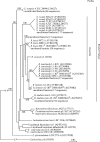Molecular diversity, cultivation, and improved detection by fluorescent in situ hybridization of a dominant group of human gut bacteria related to Roseburia spp. or Eubacterium rectale
- PMID: 16957265
- PMCID: PMC1563657
- DOI: 10.1128/AEM.00701-06
Molecular diversity, cultivation, and improved detection by fluorescent in situ hybridization of a dominant group of human gut bacteria related to Roseburia spp. or Eubacterium rectale
Abstract
Phylogenetic analysis was used to compare 16S rRNA sequences from 19 cultured human gut strains of Roseburia and Eubacterium rectale with 356 related sequences derived from clone libraries. The cultured strains were found to represent five of the six phylotypes identified. A new oligonucleotide probe, Rrec584, and the previous group probe Rint623, when used in conjunction with a new helper oligonucleotide, each recognized an average of 7% of bacteria detected by the eubacterial probe Eub338 in feces from 10 healthy volunteers. Most of the diversity within this important group of butyrate-producing gut bacteria can apparently be retrieved through cultivation.
Figures


Similar articles
-
Variations of bacterial populations in human feces measured by fluorescent in situ hybridization with group-specific 16S rRNA-targeted oligonucleotide probes.Appl Environ Microbiol. 1998 Sep;64(9):3336-45. doi: 10.1128/AEM.64.9.3336-3345.1998. Appl Environ Microbiol. 1998. PMID: 9726880 Free PMC article.
-
Lactate-utilizing bacteria, isolated from human feces, that produce butyrate as a major fermentation product.Appl Environ Microbiol. 2004 Oct;70(10):5810-7. doi: 10.1128/AEM.70.10.5810-5817.2004. Appl Environ Microbiol. 2004. PMID: 15466518 Free PMC article.
-
Phylogenetic and phenotypic evidence for the transfer of Eubacterium aerofaciens to the genus Collinsella as Collinsella aerofaciens gen. nov., comb. nov.Int J Syst Bacteriol. 1999 Apr;49 Pt 2:557-65. doi: 10.1099/00207713-49-2-557. Int J Syst Bacteriol. 1999. PMID: 10319476
-
A survey of the relative abundance of specific groups of cellulose degrading bacteria in anaerobic environments using fluorescence in situ hybridization.J Appl Microbiol. 2007 Oct;103(4):1332-43. doi: 10.1111/j.1365-2672.2007.03362.x. J Appl Microbiol. 2007. PMID: 17897237 Review.
-
Gut microbes from the phylogenetically diverse genus Eubacterium and their various contributions to gut health.Gut Microbes. 2020 Nov 9;12(1):1802866. doi: 10.1080/19490976.2020.1802866. Gut Microbes. 2020. PMID: 32835590 Free PMC article. Review.
Cited by
-
Development of a semiquantitative degenerate real-time pcr-based assay for estimation of numbers of butyryl-coenzyme A (CoA) CoA transferase genes in complex bacterial samples.Appl Environ Microbiol. 2007 Mar;73(6):2009-12. doi: 10.1128/AEM.02561-06. Epub 2007 Jan 26. Appl Environ Microbiol. 2007. PMID: 17259367 Free PMC article.
-
Pro-inflammatory flagellin proteins of prevalent motile commensal bacteria are variably abundant in the intestinal microbiome of elderly humans.PLoS One. 2013 Jul 23;8(7):e68919. doi: 10.1371/journal.pone.0068919. Print 2013. PLoS One. 2013. PMID: 23935906 Free PMC article.
-
Making target sites in large structured RNAs accessible to RNA-cleaving DNAzymes through hybridization with synthetic DNA oligonucleotides.Nucleic Acids Res. 2024 Oct 14;52(18):11177-11187. doi: 10.1093/nar/gkae778. Nucleic Acids Res. 2024. PMID: 39248110 Free PMC article.
-
Reduced dietary intake of carbohydrates by obese subjects results in decreased concentrations of butyrate and butyrate-producing bacteria in feces.Appl Environ Microbiol. 2007 Feb;73(4):1073-8. doi: 10.1128/AEM.02340-06. Epub 2006 Dec 22. Appl Environ Microbiol. 2007. PMID: 17189447 Free PMC article.
-
Novel insights into carbohydrate utilisation, antimicrobial resistance, and sporulation potential in Roseburia intestinalis isolates across diverse geographical locations.Gut Microbes. 2025 Dec;17(1):2473516. doi: 10.1080/19490976.2025.2473516. Epub 2025 Mar 16. Gut Microbes. 2025. PMID: 40089923 Free PMC article.
References
-
- Behrens, S., C. Ruhland, J. Inacio, H. Huber, A. Fonseca, I. Spencer-Martins, B. M. Fuchs, and R. Amann. 2003. In situ accessibility of small-subunit rRNA of members of the domains Bacteria, Archaea, and Eucarya to Cy3-labeled oligonucleotide probes. Appl. Environ. Microbiol. 69:1748-1758. - PMC - PubMed
-
- Collins, M. D., P. A. Lawson, A. Willems, J. J. Cordoba, J. Fernandez-Garayzabal, P. Garcia, J. Cai, H. Hippe, and J. A. Farrow. 1994. The phylogeny of the genus Clostridium: proposal of five new genera and eleven new species combinations. Int. J. Syst. Bacteriol. 44:812-826. - PubMed
-
- Duncan, S. H., G. L. Hold, A. Barcenilla, C. S. Stewart, and H. J. Flint. 2002. Roseburia intestinalis sp. nov., a new saccharolytic, butyrate producing bacterium from human faeces. Int. J. Syst. Evol. Microbiol. 52:1615-1620. - PubMed
Publication types
MeSH terms
Substances
Associated data
- Actions
- Actions
LinkOut - more resources
Full Text Sources
Other Literature Sources
Molecular Biology Databases
Miscellaneous

